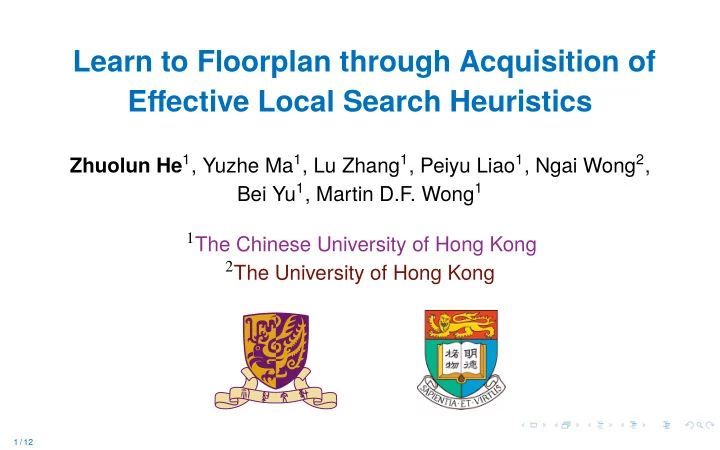

Learn to Floorplan through Acquisition of Effective Local Search Heuristics Zhuolun He 1 , Yuzhe Ma 1 , Lu Zhang 1 , Peiyu Liao 1 , Ngai Wong 2 , Bei Yu 1 , Martin D.F. Wong 1 1 The Chinese University of Hong Kong 2 The University of Hong Kong 1 / 12
Floorplanning: a Classic Problem ◮ Determine location of large blocks ◮ Minimize area, wirelength, ... ◮ Encode geometric relationship w/ dedicated data structure ◮ Perturb an encoding to generate new solutions (i.e., local search) 2 / 12
Enhancing the Local Search Method How to enhance? Existing works adopt a local search algorithm, and ◮ Select a good start point [J.A. Boyan 98, Y. Zhou 16] ◮ Tune search parameters [U. Benlic 17] ◮ Scale the regularization term [D. Beloborodov 20] ◮ Switch between heuristics on the fly [A. Nareyek 03] Our aim: acquire a local search algorithm from the scratch. Intuition: prior human knowledge might mislead the learning! 3 / 12
Learning a Local Search Heuristic We use Reinforcement Learning (RL) to learn a heuristic. Problem Description Corresponding RL Formalization ◮ An agent walks in the search space ◮ State s : a complete solution ◮ Selects a neighbor or rejects to move ◮ Action a : defined perturbations/reject ◮ Gets to neighbor state or stays ◮ Transition T : (deterministic) ◮ Optimize decision based on signals ◮ Reward r : ∆ cost Difficulties: large state/action space 4 / 12
Dealing with Large State Space: Neural Networks ◮ We use sequence pair [H. Murata 03] to encode floorplan. ◮ The state space is large: ( n !) 2 × 8 n possible states for n blocks ◮ two permutation in sequence pair ◮ rotation/flip of blocks ◮ Tabular method infeasible ◮ Solution: utilize a neural network to approximate the policy ◮ Input: features concatenated in 1D vector ◮ Output: scalar for action value prediction ◮ Architecture: a Multi-Layer Perceptron (MLP) 5 / 12
Dealing with Large Action Space: Sampling ◮ Possible actions: perturb sequence pair + rotate/flip blocks ◮ The action space is large: Θ( n 3 ) discrete actions for n blocks ◮ space size is polynomial of problem size ◮ action evaluation (state energy, action value) is costly ◮ Solution: sample actions in both training/testing ◮ We proved its convergence in DQN. 6 / 12
Area and Wirelength Minimization on MCNC ◮ Baseline: carefully tuned Simulated Annealing (SA) ◮ Cost: 0 . 6 ∗ area + 0 . 4 ∗ wirelength ◮ Our method outperforms in all cases: up to 2 . 5 % lower cost and 5 . 7 × speedup Area ( × 10 6 ) WL ( × 10 5 ) Cost ( × 10 6 ) Statistics Runtime (s) Circuit blocks nets Ours SA Ours SA Ours SA Ours SA apte 9 97 47 . 08 47.31 4 . 03 3 . 43 28 . 41 28.53 15 . 9 38.1 xerox 10 203 20 . 42 20.64 6 . 33 6.62 12 . 51 12.65 17 . 2 98.8 hp 11 83 9 . 21 9.40 1 . 95 2 . 62 5 . 60 5.74 11 . 6 44.3 1 . 24 0 . 46 0 . 77 0 . 77 43 . 1 ami33 33 123 1.25 0.69 82.2 ami49 49 408 38 . 65 39.47 17 . 24 12.31 23 . 88 24.18 66 . 8 165.0 7 / 12
Area and Wirelength Minimization on GCRS ◮ Early stop criteria: ◮ SA: no move accepted in the last 20 temperatures ◮ Our agent: no better solution found in the last 100 steps ◮ Our method shows comparable performance, yet runs slower in larger instance Area ( × 10 5 ) WL ( × 10 5 ) Cost ( × 10 5 ) Statistics Runtime (s) Circuit blocks nets Ours SA Ours SA Ours SA Ours SA 1 . 95 1 . 54 1 . 79 389 . 4 n100 100 576 1.97 1.55 1.80 396.2 n200 200 1274 2.15 2 . 01 3.48 3 . 34 2.68 2 . 54 784 . 9 1101.9 n300 300 1632 3.40 3 . 29 5 . 25 5.44 4 . 14 4.15 3766.9 2062 . 3 8 / 12
Search Progress Visualization ◮ Interpretation: smoother = ⇒ more greedy and deterministic 12 9 8 10 7 8 6 6 5 4 4 0 200 400 600 800 1 , 0001 , 2001 , 400 0 200 400 600 800 1 , 0001 , 2001 , 400 (a) Simulated Annealing (b) Our agent 9 / 12
Runtime Profiling ◮ Platform: Python, CPU+GPU ◮ Solution evaluation takes most (89.2% and 75.3%) of the runtime. ◮ Random sampling only takes a little portion of time (2.1% and 1.2%). WL Calculation WL Calculation Packing 63.1% Packing 52.3% Random Sampling Random Sampling Data Transfer 8.7% 6.9% The rest Action Generation 26.1% 2.1% 23.0% 9.7% GPU and the Rest 6.9% 1.2% (a) Simulated Annealing (b) Our agent 10 / 12
Conclusion ◮ Problem: floorplaning ◮ Motivation: ‘learn’ new algorithms without human expert knowledge ◮ Formulation: local search, selecting neighbors ◮ Method: Deep Q-learning w/ action sampling ◮ We expect more research along this line! 11 / 12
Thank You 12 / 12
Recommend
More recommend